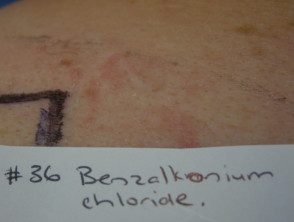What is benzalkonium chloride?
Benzalkonium Chloride is a quaternary ammonium cationic detergent. It can be used as an antiseptic and preservative in personal care, health care, home, pharmaceutical and industrial products. [1,2].
What is contact with benzalkonium chloride? dermatitis?
When benzalkonium chloride comes in contact with the skin, it can cause irritating contact dermatitis or allergic contact dermatitis in some people.
Benzalkonium chloride is a well-known irritant [1]. Benzalkonium chloride irritating contact dermatitis is more common than allergic contact dermatitis.
Who gets benzalkonium chloride contact dermatitis?
Benzalkonium chloride irritating contact dermatitis can affect anyone. Allergic contact dermatitis can affect anyone who is sensitive or allergic to benzalkonium chloride.
Benzalkonium chloride allergic and irritant contact dermatitis is more likely to occur in people with a compromised skin barrier, such as in people with atopic dermatitiseczema)
Healthcare workers are also at increased risk of developing benzalkonium chloride contact dermatitis, given the use of benzalkonium chloride in sterilization solutions and antiseptics and disinfectants in healthcare settings. [2.3].
Where is benzalkonium chloride found?
Benzalkonium chloride can be found in:
- Household cleaning products, such as rinses / laundry detergents [4]
- Personal care products [5]
-
Moisturizers, makeup removers and cleansers
-
Shampoos and hair products
-
- Wet wipes
-
Antiseptics [6]
- Eye drops and ophthalmic solutions [7]
- Glaucoma deals
- Antibacterial drops
- Corticosteroid eye drops
- Antihistamine eye drops
- Lubricating eye drops / artificial tears
- Contact lens solutions
- Nasal sprays and inhalers for asthma (tiotropium)
- Dental products
- White plaster [8,9]
- Sterilization solutions for medical instruments. [two]
- Industries, which include:
- Metallurgy
- farming
- Manufacture of textiles and dyes. [two].
How does benzalkonium chloride contact dermatitis present?
Both allergic and irritant contact dermatitis begin at the site of contact with benzalkonium chloride. In prolonged or severe cases, dermatitis can spread to other sites. [10.11]. The affected skin may be red, itchy, dry or scaly, and can also blister or peel.
Symptoms can begin to appear hours or days after contact with benzalkonium chloride. Some people may develop periorbital o eye dermatitis o conjunctivitis (red and itchy eyes) after use of benzalkonium chloride-containing ophthalmic solutions [1].
A small subset of people exposed to benzalkonium chloride may develop eruption called granular parakeratosis [4]. Granular parakeratosis is a red or brown scaly, scaly rash that most often affects skin folds, such as the armpits and groin. As the skin heals, it can peel [12].
It is believed that, in addition to being caused by occlusion, friction and sweating, granular parakeratosis can also be caused by contact with benzalkonium chloride. People with atopic dermatitis are predisposed to this condition. [4.12].
Granular parakeratosis due to contact with benzalkonium chloride

Granular parakeratosis due to contact with benzalkonium chloride
How is benzalkonium chloride contact dermatitis diagnosed?
Patch Tests are used to diagnose allergic contact dermatitis (type IV / delay hypersensitivity) to benzalkonium chloride. Benzalkonium chloride is included in Australia Base Patch testing series (tested as 0.1% aqueous benzalkonium chloride) [13].
Doubtful or weakly positive reactions of the patch test to benzalkonium chloride should be interpreted with caution. These can represent irritating reactions, rather than allergic reactions [5,14].
The open application test can also be useful to confirm reactions [14].
Dubious patch test reaction to benzalkonium chloride

Patch Test Limit Reaction to Benzalkonium Chloride
What is the treatment for contact dermatitis with benzalkonium chloride?
Once the diagnosis of contact dermatitis is confirmed, it is important to avoid contact with any product that contains benzalkonium chloride.
The affected person should be aware of the types of products that may contain benzalkonium chloride and should carefully read the ingredient labels on the product.
Avoid benzalkonium chloride along with the treatment of acute Dermatitis generally results in resolution of the rash for weeks.
In cases of contact allergy, the individual is likely to remain allergic to benzalkonium chloride indefinitely, or at least for many years.
Possible cross reactors
Benzalkonium chloride can cross react with other quaternary ammonium compounds (preservatives), such as behentrimonium methosulfate, cetrimonium chloride (cetrimide), and benzethonium chloride [5]. If someone is found to have benzalkonium chloride allergic contact dermatitis, they should also avoid these ingredients.
- Alkyl dimethyl benzyl ammonium chloride
- Alkyl dimethyl ethyl benzyl ammonium chloride
- Behentrimonium methosulfate
- Benzethonium chloride
- Cetrimonium chloride (cetrimide)
- Cetylpyridinium chloride
- Distearoylethyl dimonium chloride
- Guar hydroxypropyltrimonium chloride [5].
Active dermatitis can be treated like any eczema / acute dermatitis, with:
- Emollients
- Current steroids
-
Tacrolimus ointment or pimecrolimus cream
- Oral medications if necessary.

